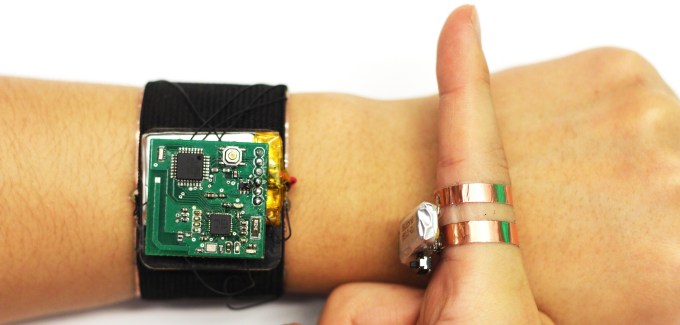Can two wearables be better than one? Carnegie Mellon University’s Human-Computer Interaction Institute (HCII) will be presenting some new research next week in which they demonstrate a technique aimed at extending the available screen space for smartwatch wearers by adding an additional wearable into the mix: a ring.
Their smartwatch-ring wearable combo offers what they describe as “a novel sensing approach” — leveraging the conductivity of human skin in order to track 2D finger touch co-ordinates in real-time and turn the area of the body directly around the smartwatch into an interactive, touch-tracking surface.
The idea being that wearables like smartwatches can feel cramped and fiddly to interact with, given how small their screens need to be to fit on the average human wrist.
The ring plus smartwatch approach would allow a watch wearer to, for example, run a finger down the back of their hand and then swipe right to scroll through an on-screen list and select an item. Or trace a letter on the back of their hand to shortcut to a particular app or silence an incoming call.
Offloading some of the necessary on-screen taps and swipes onto the surrounding skin also frees the screen from being blocked by fingers — potentially making for a superior smartwatch app experience, such as for games (the researchers use the example of playing Angry Birds in the above demo video).
They say their technique works through clothes, and is unaffected by different lighting conditions. In terms of accuracy results from the study apparently demonstrated “high reliability and accuracy with a mean distance error of 7.6mm”.
Gestures can also be transmitted contactlessly via the technique, with a finger hovering up to an inch above the surface of the skin, thanks to a partial transmission of an electrical signal owing to the human arm acting like an antenna, says CMU’s Chris Harrison, one of the scientists involved in the research.
The two components powering CMU’s prototype wearable are a battery-powered ring that continuously emits an 80MHz, 1.2Vpp AC signal into the finger on which it is worn; and a smartwatch wristband instrumented with a structured electrode pattern.
“When the user’s finger touches the skin, the electrical signal propagates into the arm tissue and radiates outwards… The signal takes time to propagate, which means electrodes located at different places around the wrist will observe characteristic phase shifts. By measuring these phase differences across several electrode pairs, SkinTrack can compute the location of the signal source (i.e., the finger), enabling real-time touch tracking on the skin,” they explain.
A prior project from HCII, back in 2014, also focused on trying to extend the surface area of a smartwatch — in that instance by using proximity sensors and projectors to display colored light buttons on the skin around the watch which could be interacted with without needing to touch the device itself.
The latest prototype is arguably a less cumbersome approach to trying to extend the interactive surface area for smartwatch wearers, with the researchers noting that it requires “no direct instrumentation of the touch area (i.e., a skin overlay)”. Although it does of course require the wearer to also charge, wear and not lose a ring.
And while we’ve seen a few attempts to fire up a market for supplementary smart rings in recent times, either as smart jewelry for notifications or as remote controls for other devices, it’s fair to say that mass consumer adoption has not yet taken place. Problem is chunky rings are, well, a matter of taste. And easily dislodged/misplaced.
Still, the CMU researchers reckon they are onto something by combining rings and smartwatches. “As our approach is compact, non-invasive, low-cost and low-powered, we envision the technology being integrated into future smartwatches, supporting rich touch interactions beyond the confines of the small touchscreen,” they write.
Harrison reckons commercialization of the technology could be possible within two to three years — assuming a smartwatch maker decides consumers can be convinced to buy into the benefit of a dual wearable. (They would also, presumably, need to fire up developers to code additional gesture controls to their smartwatch apps to take advantage of a more expansive ‘skinterface’.)
“We need to improve the stability and accuracy but its the first of it kind, so we are really excited by the potential,” Harrison tells TechCrunch.
He adds there are no trade-offs with this technique, in size terms, when it comes to the smartwatch wristband. “It could be made very small, such that it fits into existing smartwatch form factors,” he says.
The biggest downside of the approach remains the need to wear (and not lose) an additional wearable (the ring). So how small could this be? The current CMU prototype is clearly pretty cumbersome. But Harrison says the team believes it can shrink this in size by incorporating an accelerometer to maximize battery life.
“Our ring’s current battery is small, but still a bit awkward. We used this bigger battery to simplify our prototyping — it lasts 15 hours on a single charge when continuously transmitting. However, we are planning for some simple tricks that could dramatically extend that,” he says.
“For example, it is easy to increate a small accelerometer that can detect when the finger has touched something, and we can turn on the signal emission only then. That would easily bring battery life to several days or even a week, or allow us to use a much smaller battery.”
The CMU research will be presented next Tuesday, at the ACM SIGCHI Conference in San Jose.
